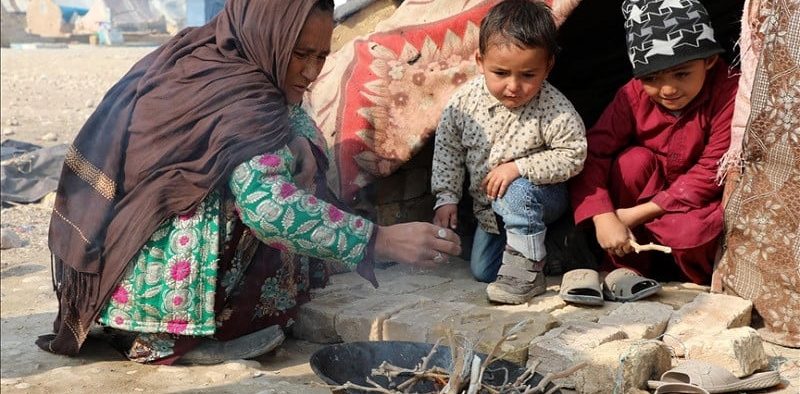Women and children in Afghanistan are most affected by the food problem

Afghanistan is just one of several nations experiencing a food crisis, with large segments of the vulnerable population bearing the brunt of a confluence of political, economic, and natural disasters.
According to the UN World Food Program (WFP), women and children are among those who are most affected by acute food insecurity in a nation emerging from decades of conflict and upheaval.
Women and girls are now among those most impacted by the food crisis, according to Philippe Kropf, the WFP’s head of communications in Afghanistan, who spoke with Anadolu.
According to the UN agency, over 16 million people, or one-third of the country’s population, are currently facing starvation, with food insecurity reaching crisis levels in every province.
15.8 million individuals have acute food insecurity, of which 3.5 million are at emergency levels, according to Kropf.
According to UN estimates, there will be one million undernourished, pregnant, and nursing women in Afghanistan by 2023, painting a dire picture for women and girls.
over 860,000 girls and boys under the age of five suffered from severe acute malnutrition, while over 2 million girls and boys under the age of five suffered from moderate acute malnutrition.
According to Kropf, “one of the worst cases—where children do, unfortunately, die regularly—is severe acute malnutrition.”
When contrasting Afghanistan with other nations facing food crises, one notable distinction is the availability of food.
As to the World Food Program, food is accessible throughout the majority of Afghanistan, even the more isolated and smaller regions.
The problem stems in the fact that households, particularly those headed by women and girls, often lack the resources to purchase it.
According to Kropf, “there is a crisis in Afghanistan where the most vulnerable people—women and children—cannot get access to the food that is on the market.”
Restrictions placed on women’s work have had a serious negative effect on households headed by women.
According to him, a large number of individuals are widows and women who are presently unable to work.
“They no longer receive a salary. They are unable to obtain employment outside of their houses, and it is getting harder for them to afford food and other necessities,” Kropf remarked.
According to him, more kids are being admitted to clinics and hospitals for malnutrition, and in certain places, all of the beds are taken.
He referenced accounts from women who were denied the opportunity to make a living or situations in which their spouses relocated to neighboring nations in search of employment but were unable to support their families financially.
The WFP representative stated, “Mothers here are relying a lot on borrowing food and money, both from shopkeepers and also from relatives.”
“They have very few opportunities left to take care of themselves and their children, and they are at a critical point.”
Funding reductions and food security
The Taliban retook control of Afghanistan in August 2021.
Since then, donor contributions and ongoing, extensive food assistance have helped millions of people escape the verge of starvation, according to Kropf.
He said that the crop the previous year was likewise a little better.
He referenced accounts from women who were denied the opportunity to make a living or situations in which their spouses relocated to neighboring nations in search of employment but were unable to support their families financially.
The WFP representative stated, “Mothers here are relying a lot on borrowing food and money, both from shopkeepers and also from relatives.”
“They have very few opportunities left to take care of themselves and their children, and they are at a critical point.”
Funding reductions and food security
The Taliban retook control of Afghanistan in August 2021.
Since then, donor contributions and ongoing, extensive food assistance have helped millions of people escape the verge of starvation, according to Kropf.
He said that the crop the previous year was likewise a little better.
It was the first crop that was average in a number of years. Thus, the situation of food security has somewhat improved, but we run the risk of losing what we have gained,” he said.
We’ve reached a point where things have somewhat stabilized. Although the status of the economy is better now than it was two years ago, it is still not excellent.
One significant problem is that the World Food Program (WFP) had to remove around 10 million individuals from aid programs in Afghanistan in 2023 due to a severe budget crisis.
According to Kropf, these included 1.4 million women and children who were no longer receiving specialized meals meant to prevent and cure malnutrition. He also stated that the organization is still dealing with a “huge funding crisis.”
He claimed that rather than “playing one humanitarian crisis against the other,” there are now “many more people in need of emergency food assistance” due to the multitude of crises that are occurring worldwide.
Of course, some crises make more news than others. Thus, we’re urging all of our partners and funders to keep in mind the Afghan women, men, girls, and boys in need of help,” he stated.
Zabihullah Mujahid, a spokesperson for the Taliban, had previously stated that although Afghanistan’s economic position was “normal,” it was affected by the “40 years of war in the country.”
“The nations that support us ought to work together more. He said to local TV Tolo News, “We want more help from them and we appreciate their help.”
Climate change’s effects
Afghanistan’s food crisis is also exacerbated by the fact that it is “one of the countries most affected by the climate crisis,” Kropf pointed out.

I am a dedicated student currently in my seventh semester, pursuing a degree in International Relations. Alongside my academic pursuits, I am actively engaged in the professional field as a content writer at the Rangeinn website.








